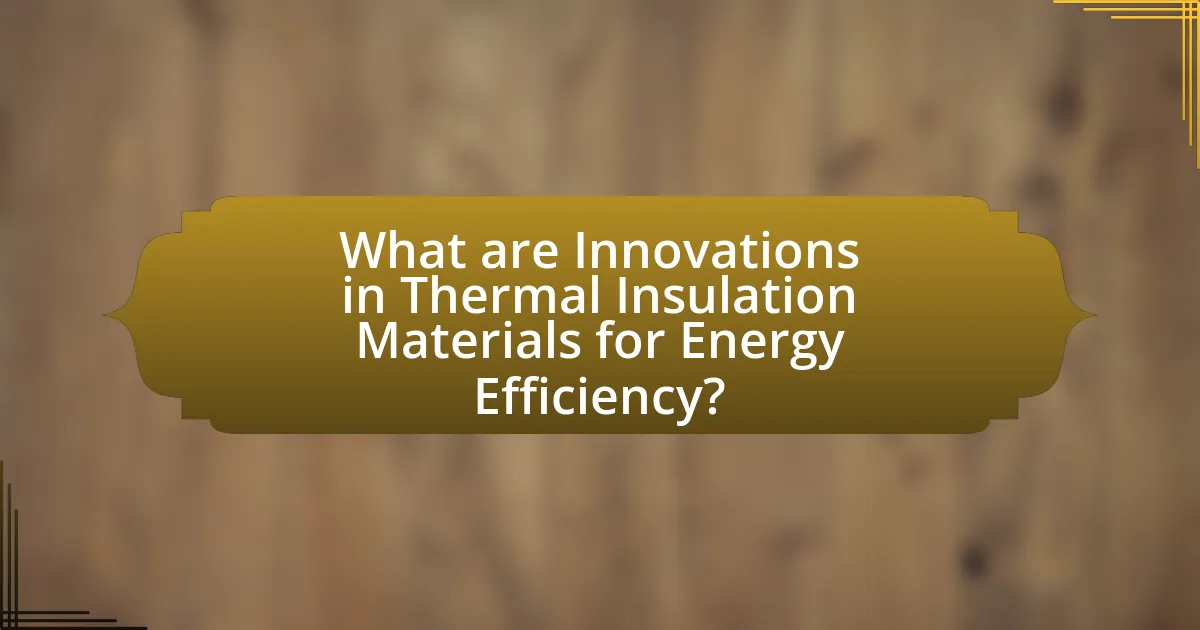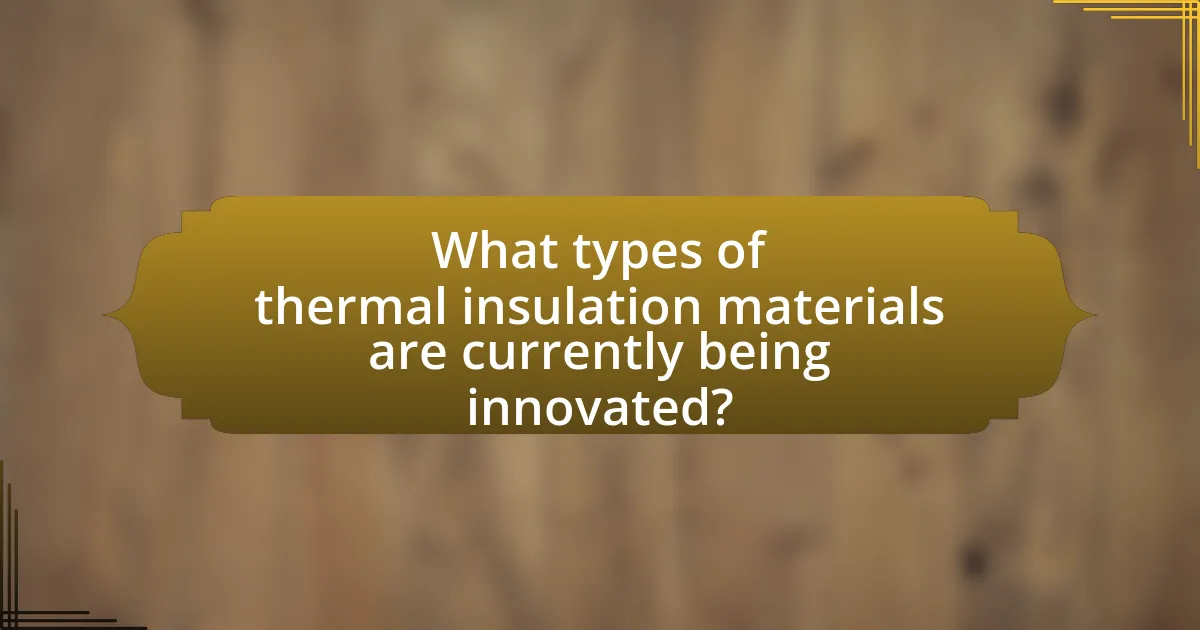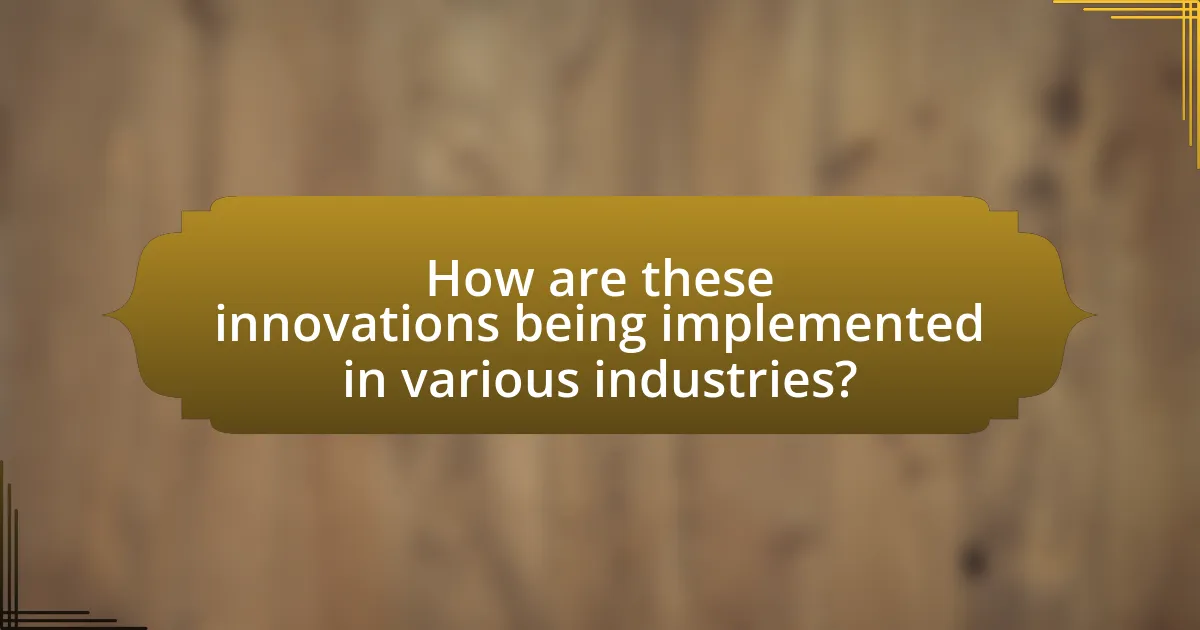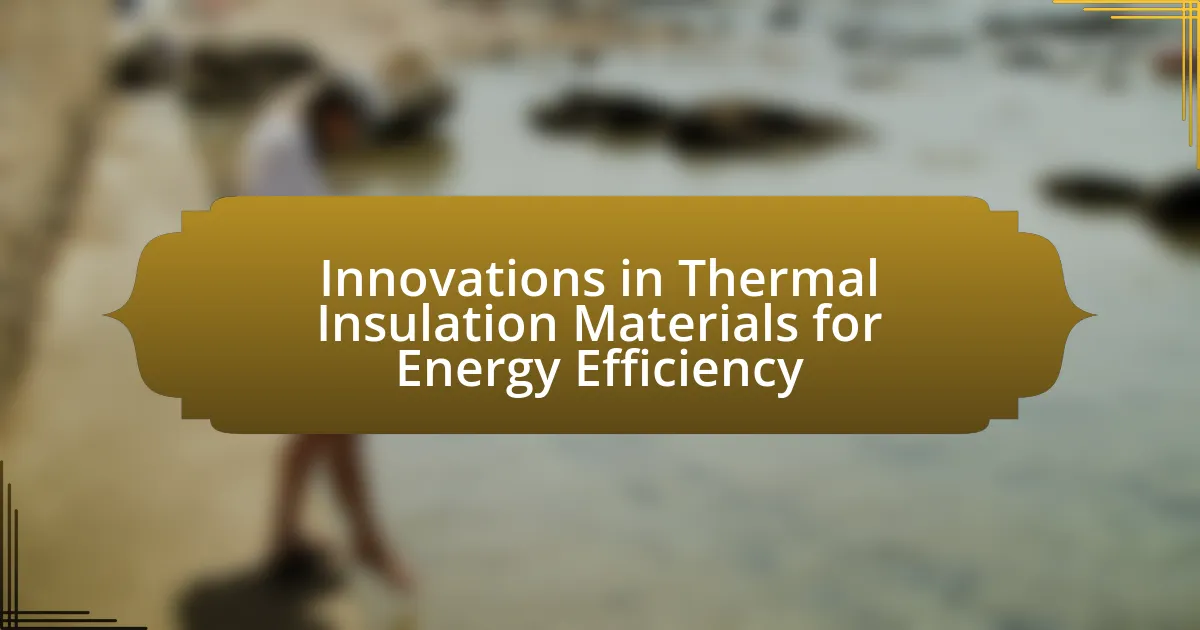Innovations in thermal insulation materials are crucial for enhancing energy efficiency in buildings and reducing energy consumption. Key advancements include aerogels, vacuum insulation panels, and phase change materials, which significantly outperform traditional insulation options in thermal resistance and sustainability. These materials not only lower energy costs by minimizing heat transfer but also contribute to global sustainability goals by reducing greenhouse gas emissions. The article explores the technologies driving these innovations, their impact on various industries, and the challenges manufacturers face in their development and adoption.

What are Innovations in Thermal Insulation Materials for Energy Efficiency?
Innovations in thermal insulation materials for energy efficiency include the development of aerogels, vacuum insulation panels, and phase change materials. Aerogels, known for their low thermal conductivity, can reduce heat transfer significantly, making them ideal for energy-efficient buildings. Vacuum insulation panels offer superior insulation performance due to their evacuated cores, which minimize heat flow. Phase change materials, which absorb and release thermal energy during phase transitions, help maintain stable indoor temperatures, thus enhancing energy efficiency. These advancements contribute to reduced energy consumption in residential and commercial buildings, aligning with global sustainability goals.
How do these innovations impact energy consumption?
Innovations in thermal insulation materials significantly reduce energy consumption by enhancing the energy efficiency of buildings. These advanced materials, such as aerogels and phase change materials, minimize heat transfer, thereby decreasing the need for heating and cooling systems. For instance, studies indicate that buildings utilizing high-performance insulation can achieve energy savings of up to 30% compared to those with traditional insulation. This reduction in energy demand not only lowers utility costs but also contributes to decreased greenhouse gas emissions, aligning with global sustainability goals.
What specific technologies are driving these innovations?
Advanced thermal insulation materials are primarily driven by technologies such as aerogel production, vacuum insulation panels (VIPs), and phase change materials (PCMs). Aerogels, known for their low thermal conductivity, are created through a sol-gel process that replaces liquid in a gel with gas, resulting in a lightweight and highly insulating material. Vacuum insulation panels utilize a vacuum to minimize heat transfer, achieving superior insulation performance compared to traditional materials. Phase change materials enhance energy efficiency by absorbing and releasing thermal energy during phase transitions, thus stabilizing indoor temperatures. These technologies collectively contribute to significant energy savings and improved thermal performance in building applications.
How do these materials compare to traditional insulation options?
Innovative thermal insulation materials often outperform traditional options in terms of energy efficiency and environmental impact. For instance, materials like aerogel and vacuum insulation panels provide superior thermal resistance, with aerogel achieving an R-value of up to 10 per inch, compared to fiberglass insulation, which typically offers an R-value of 2.9 to 4.3 per inch. Additionally, many modern materials are made from sustainable resources, reducing the carbon footprint associated with production, unlike conventional insulation that may rely on petrochemical products. These advancements not only enhance energy savings but also contribute to more sustainable building practices.
Why is energy efficiency important in today’s context?
Energy efficiency is crucial in today’s context due to its role in reducing greenhouse gas emissions and lowering energy costs. As global energy demand continues to rise, improving energy efficiency can significantly mitigate climate change impacts; for instance, the International Energy Agency reported that energy efficiency measures could account for over 40% of the emissions reductions needed to meet climate targets by 2040. Additionally, enhancing energy efficiency in buildings through innovations in thermal insulation materials can lead to substantial savings on energy bills, with studies indicating that energy-efficient buildings can reduce energy consumption by up to 50%.
What role do thermal insulation materials play in reducing energy costs?
Thermal insulation materials significantly reduce energy costs by minimizing heat transfer between the interior and exterior of buildings. By effectively slowing down the conduction, convection, and radiation of heat, these materials maintain desired indoor temperatures, thereby decreasing the reliance on heating and cooling systems. For instance, according to the U.S. Department of Energy, proper insulation can reduce energy bills by 10% to 50%, depending on the climate and the type of insulation used. This reduction in energy consumption not only lowers costs but also contributes to environmental sustainability by decreasing greenhouse gas emissions associated with energy production.
How do these innovations contribute to sustainability efforts?
Innovations in thermal insulation materials significantly contribute to sustainability efforts by enhancing energy efficiency in buildings. These advanced materials reduce heat loss and gain, leading to lower energy consumption for heating and cooling. For instance, studies show that improved insulation can decrease energy use by up to 30%, thereby reducing greenhouse gas emissions associated with energy production. Additionally, many of these materials are made from recycled or sustainable resources, further minimizing environmental impact. This dual benefit of energy savings and resource conservation underscores the critical role of thermal insulation innovations in promoting sustainability.

What types of thermal insulation materials are currently being innovated?
Currently, innovative thermal insulation materials include aerogels, vacuum insulation panels (VIPs), and phase change materials (PCMs). Aerogels, known for their low density and high thermal resistance, are being developed for applications in building insulation and industrial processes. Vacuum insulation panels offer superior insulation performance due to their low thermal conductivity, making them ideal for energy-efficient buildings. Phase change materials are being enhanced to improve their thermal storage capabilities, allowing for better temperature regulation in buildings. These innovations are supported by research indicating that these materials can significantly reduce energy consumption in heating and cooling applications.
What are the characteristics of advanced insulation materials?
Advanced insulation materials exhibit high thermal resistance, lightweight properties, and moisture control capabilities. These materials, such as aerogels and vacuum insulation panels, provide superior thermal performance with lower thickness compared to traditional insulation. For instance, aerogels can achieve thermal conductivities as low as 0.013 W/m·K, significantly enhancing energy efficiency in buildings. Additionally, advanced insulation materials often incorporate sustainable components and are designed to minimize environmental impact, aligning with modern energy efficiency standards.
How do aerogels enhance thermal performance?
Aerogels enhance thermal performance by providing exceptional insulation due to their low thermal conductivity, which can be as low as 0.013 W/m·K. This property arises from their highly porous structure, composed of up to 99.8% air, minimizing heat transfer through conduction, convection, and radiation. Studies have shown that aerogels can outperform traditional insulation materials, such as fiberglass and foam, by a factor of three to four in terms of thermal resistance. This efficiency makes aerogels particularly valuable in applications requiring lightweight and space-saving insulation solutions, such as in aerospace and building construction.
What benefits do phase change materials offer?
Phase change materials (PCMs) offer significant benefits in energy efficiency by enhancing thermal regulation in buildings. These materials absorb and release thermal energy during phase transitions, which helps maintain stable indoor temperatures and reduces reliance on heating and cooling systems. For instance, studies have shown that incorporating PCMs in building materials can lead to energy savings of up to 30% by minimizing temperature fluctuations. Additionally, PCMs contribute to improved comfort levels for occupants by providing a more consistent thermal environment.
What are the emerging trends in thermal insulation technology?
Emerging trends in thermal insulation technology include the development of advanced materials such as aerogels, vacuum insulation panels, and phase change materials. Aerogels, known for their low thermal conductivity, can achieve insulation performance with minimal thickness, making them ideal for space-constrained applications. Vacuum insulation panels offer superior thermal resistance by eliminating air, thus reducing heat transfer significantly. Phase change materials enhance energy efficiency by absorbing and releasing heat during phase transitions, stabilizing indoor temperatures. These innovations are supported by research indicating that such materials can improve energy efficiency in buildings by up to 30%, as highlighted in studies from the International Energy Agency.
How is nanotechnology influencing insulation materials?
Nanotechnology is significantly enhancing insulation materials by improving their thermal performance and reducing weight. The incorporation of nanomaterials, such as silica nanoparticles and carbon nanotubes, leads to increased thermal resistance and lower thermal conductivity, which results in more efficient insulation solutions. For instance, studies have shown that adding just a small percentage of nanoparticles can improve the insulation properties of traditional materials by up to 30%. This advancement not only contributes to energy efficiency in buildings but also allows for thinner insulation layers, optimizing space without compromising performance.
What role does smart insulation play in energy efficiency?
Smart insulation significantly enhances energy efficiency by dynamically adjusting thermal resistance based on environmental conditions. This technology minimizes heat loss in winter and reduces heat gain in summer, leading to lower energy consumption for heating and cooling. For instance, studies have shown that buildings equipped with smart insulation can achieve energy savings of up to 30% compared to traditional insulation methods. This efficiency is primarily due to the materials’ ability to respond to temperature changes, optimizing indoor climate control and reducing reliance on HVAC systems.

How are these innovations being implemented in various industries?
Innovations in thermal insulation materials for energy efficiency are being implemented across various industries through the adoption of advanced materials such as aerogels, phase change materials, and vacuum insulation panels. In the construction industry, these materials are utilized to enhance building energy performance, with aerogels providing superior thermal resistance while reducing overall weight, thus improving structural efficiency. The automotive sector employs phase change materials to regulate temperature within vehicles, enhancing passenger comfort and reducing energy consumption for climate control systems. Additionally, the refrigeration industry integrates vacuum insulation panels to minimize energy loss, achieving higher energy efficiency ratings for appliances. These implementations are supported by studies indicating that advanced insulation materials can reduce energy consumption by up to 30% in buildings and appliances, demonstrating their effectiveness in promoting energy efficiency.
What sectors are adopting advanced thermal insulation materials?
The construction and building sector is adopting advanced thermal insulation materials to enhance energy efficiency. This sector utilizes materials such as aerogels, vacuum insulation panels, and phase change materials to reduce energy consumption in residential and commercial buildings. According to a report by the International Energy Agency, the building sector accounts for nearly 40% of global energy consumption, highlighting the critical need for improved insulation solutions to achieve energy efficiency goals.
How is the construction industry benefiting from these innovations?
The construction industry is benefiting from innovations in thermal insulation materials by achieving enhanced energy efficiency and reduced operational costs. These advanced materials, such as aerogels and phase change materials, provide superior thermal performance, leading to lower energy consumption for heating and cooling buildings. For instance, studies have shown that buildings utilizing high-performance insulation can reduce energy costs by up to 30%. Additionally, these innovations contribute to sustainability goals by minimizing carbon footprints, as energy-efficient buildings require less energy from fossil fuels.
What applications are seen in the automotive sector?
The automotive sector utilizes thermal insulation materials primarily for enhancing energy efficiency in vehicles. These materials are applied in various components such as engine compartments, exhaust systems, and passenger cabins to reduce heat loss and improve thermal management. For instance, advanced insulation materials like aerogels and multi-layered composites are employed to minimize heat transfer, thereby increasing fuel efficiency and reducing emissions. According to a study by the National Renewable Energy Laboratory, effective thermal insulation can improve vehicle energy efficiency by up to 15%.
What challenges do manufacturers face in developing these materials?
Manufacturers face several challenges in developing thermal insulation materials for energy efficiency, primarily related to material performance, cost, and regulatory compliance. The need for materials that provide superior thermal resistance while being lightweight and durable complicates the development process. Additionally, high production costs can hinder the adoption of innovative materials, as manufacturers must balance quality with affordability to remain competitive in the market. Regulatory compliance poses another challenge, as manufacturers must ensure that their products meet stringent environmental and safety standards, which can vary significantly across regions. These challenges are compounded by the rapid pace of technological advancements, requiring manufacturers to continuously innovate while managing existing production capabilities.
How do cost and scalability affect the adoption of new insulation technologies?
Cost and scalability significantly influence the adoption of new insulation technologies by determining their accessibility and practicality for widespread use. High initial costs can deter consumers and builders from investing in innovative insulation solutions, as they often seek cost-effective options that fit within budget constraints. For instance, advanced materials like aerogels, while highly efficient, can be prohibitively expensive compared to traditional insulation, limiting their market penetration.
Scalability also plays a crucial role; technologies that can be easily produced and integrated into existing manufacturing processes are more likely to be adopted. For example, insulation materials that can be mass-produced at lower costs, such as spray foam or cellulose, tend to see higher adoption rates due to their affordability and ease of application. According to a report by the U.S. Department of Energy, the cost-effectiveness of insulation technologies is a primary factor influencing energy efficiency upgrades in residential and commercial buildings. Thus, both cost and scalability are essential in determining the viability and acceptance of new insulation technologies in the market.
What regulatory hurdles must be overcome for widespread use?
Widespread use of innovations in thermal insulation materials for energy efficiency must overcome regulatory hurdles related to building codes, safety standards, and environmental regulations. Building codes often dictate the types of materials that can be used in construction, requiring compliance with specific performance criteria. Safety standards, such as fire resistance and toxicity levels, must be met to ensure that new materials do not pose risks to occupants. Additionally, environmental regulations may require assessments of the lifecycle impacts of these materials, including their production, use, and disposal. For instance, the U.S. Environmental Protection Agency (EPA) enforces regulations that can affect the approval and use of insulation materials, necessitating thorough testing and documentation to demonstrate compliance.
What practical tips can be applied for selecting thermal insulation materials?
When selecting thermal insulation materials, prioritize factors such as thermal resistance (R-value), moisture resistance, and environmental impact. The R-value indicates the material’s effectiveness in resisting heat flow; higher values signify better insulation performance. Additionally, consider moisture resistance to prevent mold growth and degradation, which can compromise insulation effectiveness. Environmental impact is crucial; opt for materials with low embodied energy and those that are recyclable or made from renewable resources. For instance, fiberglass and cellulose insulation are known for their favorable R-values and lower environmental footprints compared to traditional materials.

Leave a Reply